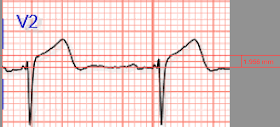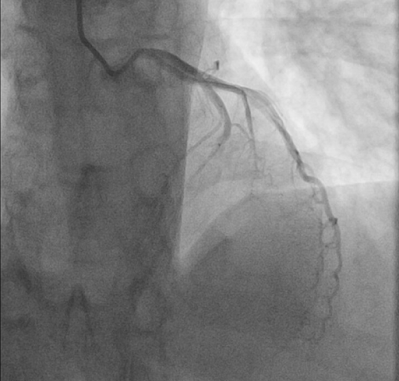This case was contributed by Brooks Walsh, an emergency physician in Connecticut.
Don't trust the "Normal ECG"
It's important to periodically reemphasize that the computerized ECG interpretation can miss critical findings.
Some authors have suggested that ECGs interpreted as "normal" by the computer are "unlikely" to be significant. However, "unlikely" is doing a lot of the heavy lifting in that conclusion!
The challenge of emergency medicine, after all, is to churn though the sea of benign presentations, looking for that "unlikely" crucial diagnosis. If you "outsource" this vigilance to the computer, you might miss that critical presentation.
The Case
An older person came to the emergency department with chest discomfort. It was not severe, but it was uncomfortable, and had not improved after an hour.
An ECG was obtained immediately at triage:
The computer program read this as "Normal Sinus Rhythm, Normal ECG." Can we trust this?
Probably not in this case.
First of all, there's some pretty suggestive ST elevation in the anterior leads...
... along with reciprocal ST depression in lead III.
12 Example Cases of Use of 3- and 4-variable formulas to differentiate normal STE from subtle LAD occlusion
So we're concerned about the ECG - How did the patient do? Well, although the cardiac team was immediately activated, there were issues with moving to the cath lab directly.
Fortunately, the patient was able to soon proceed to the cath lab, now only reporting 1/10 chest pain. Given the improved symptoms and a "normal" ECG (followed by a "normal-er" ECG), one might expect the angiography to find only a minor or partial obstruction.
Nope.
Angiography showed a TIMI 0 lesion in the mid-LAD. Following placement of 2 stents, TIMI 3 flow was restored.










In Avl there is a worrisome hint of st elevation, do you agree ??
ReplyDeleteNo doubt about it
DeleteDr Brooks Walsh, thank you for the great ECG post (March 13th 2021) with an excellant message. There cannot be a second opinion other than LAD/OMI in this blog ECG. If the ECG computer offers a clean chit report, then it is the result of technological shortcoming. All my ECG learning residents are wary of this problem and dont care to even look at the computer report. When in doubt, they consult me, and when I am in doubt, I consult Dr. Smith and Dr. Ken Grauer and Dr Pendell Meyers directly or indirectly through their excellent Books and Blogs. With regards,
ReplyDeleteDr. R.Balasubramanian. PONDICHERRY - INDIA.
Greetings from Spain, you do such a good work with you blog's posts! Which is th significance of the QRS's notch visible in II, III, aVF, V1, V2, V3 leads? Thank you in advance
ReplyDeleteIt is an early Q-wave and further supports the diagnosis of OMI.
DeleteGlad you like the posts!